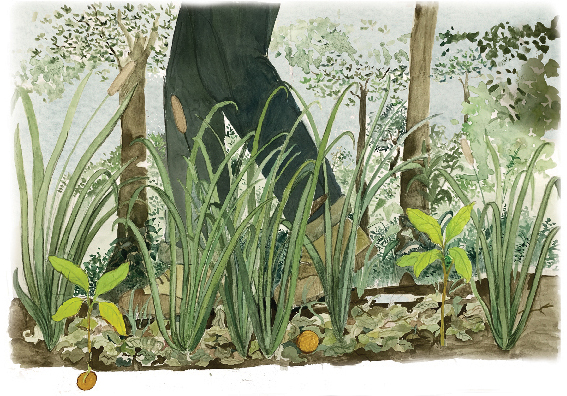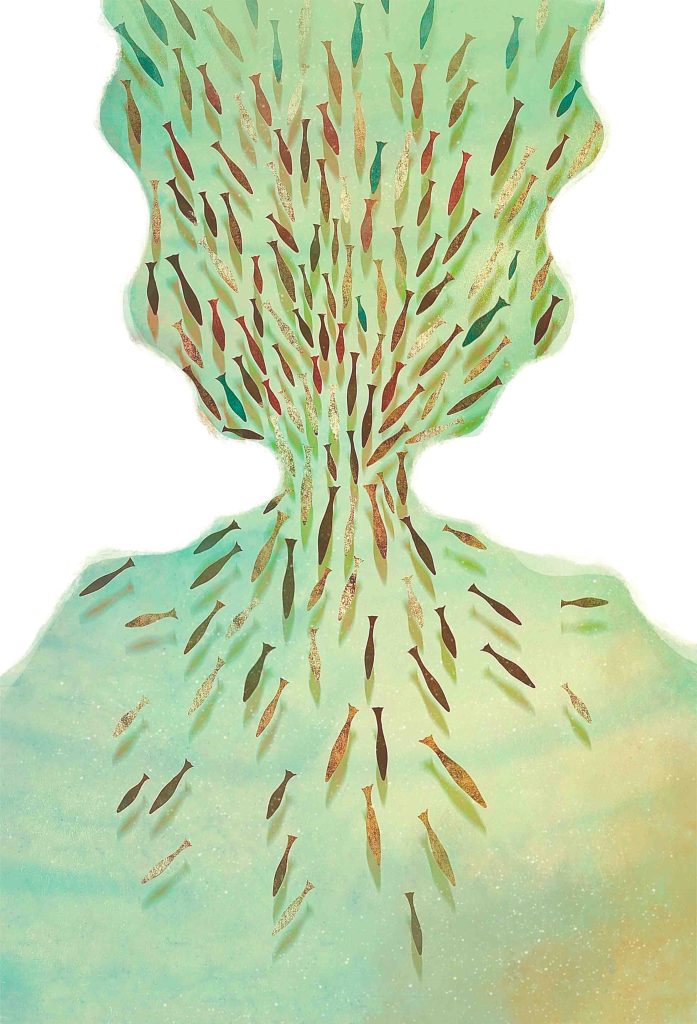In the tropical evergreen forests of the southern Western Ghats of India—more than 9000 miles away from the land of the largest tree in the world, the California redwood (Sequoia sempervirens)—dwells the Tirunelveli redwood tree (Gluta travancorica). Clustered populations of this majestic tree grow to a height of 35–45 m and are distributed in discontinuous small as well as large patches at an elevational range of 300–1200 m above sea level. The species belongs to the family Anacardiaceae, commonly known as the cashew family or the sumac family. Gluta comes from the Latin word ‘gluten’ or ‘glutus’, referring to the petals which are glued to the stipe (the stalk that supports the flower’s ovary, while travancorica refers to the erstwhile kingdom of Travancore, where the tree occurs. Different vernacular names like ‘thenmavu’, ‘thodappei’, ‘chenkurinji’, and ‘shenkurinji’ have been attributed to the tree, based on its distribution in the South Indian states of Tamil Nadu and Kerala.
According to the IUCN Red List database, the Tirunelveli redwood or chenkurinji is classified as ‘near threatened’. The species was heavily logged for its ornamental hardwood in the past, during the reign of the Travancore kings, and later by the British. This red-coloured heartwood was cut down for building construction, making cabinets and furniture, decorative interior joinery, turnery articles and carvings, tool handles, and shipbuilding. The bruised surface of the bark of G. travancorica and allied species exudes an acrid resinous juice that turns black on air exposure and is used as lacquer. One such species, Gluta usitata, is commonly known as Burmese lacquer because of the characteristic bole, which is tapped for its lacquer. Most species in the Anacardiaceae family contain an irritant class of compounds called urushiols. Similarly, the resinous exudate from G. travancorica can cause extreme contact allergies in some people. Therefore, caution should be exercised while touching any part of this tree.
In the current scenario, logging of G. travancorica is strictly prohibited by the Kerala Preservation of Trees Act 1986. This has curbed the extent of logging. However, chenkurinji is a sensitive, altitude-specific tree, especially at the seedling stage. This has put a massive dent in the afforestation activities focused on the species in the past few years.

There are few places like the Western Ghats, which is considered one of the ‘hottest’ biodiversity hotspots in the world. It has been estimated that around 5800 species of flowering plants are located here, of which 56 genera and 2100 species (which includes 650 trees) are categorised as endemic to this region. G. travancorica is one such tree which is so uniquely and narrowly endemic that the Shendurney Wildlife Sanctuary in Kerala is named after the vernacular name of the tree—chenkurinji. In 1984, the Shendurney Valley was proclaimed a Wildlife Sanctuary and became the only Sanctuary in the Kollam district to date. In its native habitat, a few other tree species commonly associated with G. travancorica are Cullenia exarillata, Mesua ferrea, and Palaquium ellipticum. Another notable feature is the tree’s association with understorey species from the genera Pandanus and Calamus. This undergrowth protects the seedlings from being grazed by foraging animals. Eventually, when a forest gap is created, those seedlings with greater survival ability will emerge from the undergrowth.
The extreme pruning of these lower canopy associates is more prominent in areas where there is tourist activity. The sholas (tropical montane grasslands) of Ponmudi, which are home to a few hundred chenkurinji trees, have a substantial tourist presence, which has resulted in the clearing of many spiny plants like Calamus. This clearing, in conjunction with trampling by visitors, has left the forest floor devoid of the ideal environment for the seeds to grow. The adjacent area of Brymore is also home to a small population of Gluta with nearly 50 individuals. But in this area, fireline burning often destroys fallen mature seeds. These are also common issues faced by most other native trees sharing a similar habitat.
The story of the ancestors of the genus Gluta dates back to 200 million years ago when the Gondwana land started splitting. Of the 35 or more Gluta species present in the world, most are spread across Southeast Asia, and only three are found in isolated land masses outside the Malayan Peninsula. The three deviants are G. tourtour in Madagascar, the highly threatened G.papuana in Papua New Guinea, and the near threatened G. travancorica in the Western Ghats of India. The common ancestor of G. tourtour and G. travancorica got separated when Madagascar and India split about 70 million years ago. The Indian subcontinent collided with Asia and has been moving northeast from Africa ever since. Buried within the character traits in their seeds lie untold stories and the long-forgotten origins of the species. G. tourtour is a species endemic to the coastal marshlands of Madagascar. After millions of years of geographic isolation and evolution the species has adapted to live in a mangrove ecosystem and also shows vivipary—the ability of seeds to germinate when still attached to the parent tree. Remnants of this unique feature of marshland Glutas can be seen in the montane species—G. travancorica. Among the thousan ds of seeds produced by chenkurinji trees, a few show vivipary, especially if these seeds are shed during the peak monsoon.
Gluta usitata is a common species of Gluta found in many parts of Southeast Asia. It is characterised by pinkish-white petals which are modified to form wings in mature fruits. This is a very efficient seed dispersal technique that was lost in G. travancorica and a few other species after the split of Gondwana land, when they became isolated and started evolving separately. Fossil wood resembling the modern day G. travancorica, and dating back to the Early Eocene period nearly 50 million years ago, was unearthed from a lignite mine in the Bharuch district of Gujarat. This shines some light on the present day Gluta travancorica, which diverged from a tropical wetland gene pool and must have been present throughout India at some point in history. As the Indian subcontinent moved away from the Equator, the central and northern regions of India, which once were home to dense tropical forests, gradually turned to arid scrub jungles and deserts. This northeast movement of the Indian plate at a rate of 5 cm/year is an ongoing process. Accompanied by the current level of global climate change and rising global temperature, there will be imminent changes in the tropical forests of the Western Ghats. Therefore, from a geological evolutionary point of view, the future of G. travancorica is uncertain.

Returning to the present, the poor rate at which new seedlings are establishing and growing into adult trees in the forests, coupled with the narrow distribution are issues that can further endanger G. travanacorica populations. Since trees take several decades to mature into an adult population from seeds, a lack of regeneration and establishment becomes alarming, despite having a sizable stable adult tree population in-situ. Other species of Gluta have seeds floating across oceans and flying over picturesque mountains only to fall on suitable substrate and eventually germinate. Evolution has left chenkurinji handicapped in both these respects. Yet, there’s hope because field studies of the population have revealed strong survival traits, such as regrowth of fire-destroyed tree stumps, new shoot emergence in dried-up seedlings, and seeds germinating after being buried in leaf litter on the forest floor for nearly a year. However, given the imminent threats of tourism, landslides, and the construction of roads, there is an immediate need for implementing action plans to extend its natural habitat. The best conservation plan for habitat-specific trees like G. travancorica, is to reintroduce seedlings in forest gaps in the same environment where they grow naturally.
Further Reading
Rao, R. R. and R. Raghavendra. 2012. Floristic diversity in Western Ghats: Documentation, conservation and bio prospection—A priority agenda for action. In: Sahyadri E_news Issue XXXVIII. Bangalore: ENVISECES, Indian Institute of Science.
Jose, P. A. and A. G. Pandurangan. 2013. Vivipary in Gluta travancorica: Its phytogeographic and evolutionary significance. Nelumbo (55): 89–93.
Namitha, L. H. and S. Suhara Beevy. 2020. Morphology and phytogeography of Gluta (L.) Ding Hou-A Review. Plant Archives 20(1): 2309–2319.






